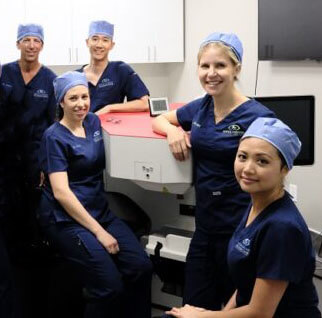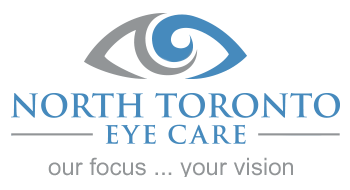Cataract Surgery & Laser Assisted Cataract Surgery
Click Here For More Information
Cataract surgery, which replaces the eye’s cloudy lens with an artificial, clear intraocular lens, is the most common operation in Canada. It is a quick and minimally invasive procedure that involves numbing the eyes, then making a tiny incision into the cornea, in which an ultrasonic probe is inserted. The probe emulsifies (breaks up) the cloudy lens into tiny pieces, and then suctions the pieces out of the eye. Once the cloudy lens has been removed, a new artificial lens is implanted into the eye. This lens is known as an intraocular lens (IOL), and is inserted through the same incision that the old lens was removed from. No sutures or stitches are required to close the incision as it will self-seal.
Surgery usually takes less than 15 minutes to perform and is painless for most patients. After the procedure, a patch is placed over the eye and you will be asked to rest and then go home the very same day. You will need someone to drive you home. For the next few days, you may experience itching, mild discomfort, blurry vision, and sensitivity to light and touch. Your doctor will prescribe eye drops to help the healing process and to reduce the risk of infection.
Cataract surgery can significantly increase your quality of life by allowing you to gain more independence and resume activities you may have stopped due to cataracts affecting your vision, such as driving and reading. It has been shown that having cataract surgery can reduce the risk of falls in the elderly population. According to an article posted by the New York Times, cataract surgery could also prolong your life!
What to Expect the Day of Cataract Surgery
Risks and Complications
Although cataract surgery is considered safe, there are risks associated with any surgery. Some of these risks may include increase in dryness, pain, infection, increase in floaters, and corneal swelling. Most patients undergo this procedure without any complications.
Surgery Options

Femtosecond Laser-Assisted Cataract Surgery
Cataract surgery can be performed two ways: Traditional (Manual) or FEMTOSECOND LASER-ASSISTED.
Traditional cataract surgery involves the surgeon using a blade to create an incision into the cornea and uses tools to create a capsule opening to reach the cloudy cataract lens. Then he/she uses an ultrasonic probe to break up the cataract.
Femtosecond laser-assisted cataract surgery allows the surgeon to use the laser to create a very precise corneal incision, and create a perfect capsule opening. Afterwards, the laser gently fragments the cloudy lens. Due to the laser’s high level of accuracy, it can also create peripheral corneal relaxing incisions to correct mild amounts of astigmatism. Find out more here.
Intraoculat Lens Implant Options
There are several different IOL options available to help each patient achieve the best possible results from cataract surgery. Our practice provides IOL options including monofocal, multifocal, and extended depth of focus lenses. We will help you to determine which IOL is best for your lifestyle and vision needs. If you have astigmatism, you would need a TORIC IOL (which can either be monofocal or multifocal).
Not all lens options are suitable for your lifestyle demands and not everyone is a candidate for all of the IOL options. These choices are discussed in depth at your consultation with your surgeon. Find out what IOL options we offer here.
Insurance Coverage
Refractive correction services that are offered during cataract surgery can include special-feature intraocular lenses like multifocal and accommodating IOLs, femtosecond laser-assisted cataract surgery, and other specialized diagnostics. These services are an additional cost to patients because they are not deemed medically necessary. Newer innovations for cataract surgery aim to enhance refractive outcomes for patients who are hoping to be independent of glasses or contacts but at a financial cost.
NTEC Cataract Technology Offerings: Advancing Technology for Your Sight
- LENSX Laser System
- CATALYS® Precision Laser System
- VERION Image Guided System
- Intralase IFS Femtosecond Laser
- Centurian Vision System
- OPD Scan III Refractive Power / Corneal Analyzer
- IOLMaster Coherence Tomography
- Lenstar
- Pentacam
- Endothelial Cell Count/Specular Microscope
- A-Scan
- I-Trace
- Nidek BCVA
Cataract Patient Instructions
- Pre-operative Instructions
- Post-operative Instructions
- North Toronto Eye Surgery Centre Driving Directions
- NYGH Minor Surgical Procedures and Elder Care Centre Eye Surgery Centre Admission Instructions
- Kensington Eye Institute Admission Instructions
- TLC Yonge & Eglinton Cataract Surgery Package
- Femto Patient Consent Form for Kensington Eye Institute
Cataract Surgery Locations
Cataract Surgery can be performed at the following locations:
- North Toronto Laser Cataract Centre
- The Kensington Eye Institute
- NYGH Minor Surgical Procedures and Elder Care Centre | Eye Surgery Centre Site
- Yonge-Eglinton Laser Eye & Cosmetic Centre
